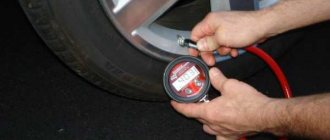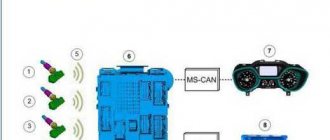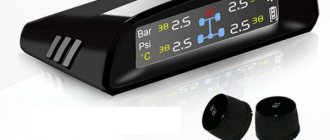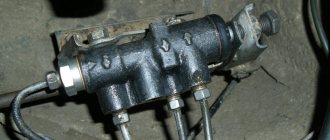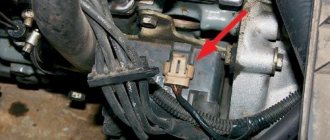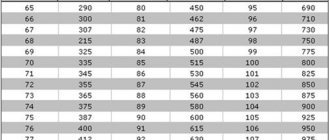Last year, sales of a new domestically produced product began - the LADA Vesta SW CROSS station wagon. Maybe there’s not much that’s domestic left in it, but the car was made here, at our factory! And from the fact that the car turned out to be successful in terms of construction, design and sales, one can only be happy for the new product. A distinctive feature from all previous models produced by AvtoVAZ was the installation of simply huge ones (by Lada standards). We have already talked about them in one of our articles, and today we will look at the topic of the Lada Vesta SV Cross tire.
Lada Vesta SV Cross tires, as for any other car, are one of the most important elements. Not only handling and braking distance depend on them, but also indicators such as fuel consumption, road stability, acceleration, and overall engine power. In addition, tires affect ride comfort and wear on the suspension in general. That is why it is important to use only tires specified by the manufacturer.
The table below shows the tire sizes of the Lada Vesta Cross SV.
After analyzing the table, we can conclude that the manufacturer recommends using only one tire size - 205/50 R17 with different load capacity and speed indices.
But what should those who want to install wider or higher tires do?
It is possible to install tires a little wider, for example, in this case, tires with a width of 215 are suitable. You can also use narrower tires, for example, with a width of 195.
| Tires and Wheels Lada Vesta SW Cross | |
| Tires | Discs |
| 195/65R15 | 6.0Jx15 ET37 |
| 205/55R16 | 6.0Jx16ET40 |
| 205/50R17 | 6.5Jx17 ET41 |
| 205/45R18 | 7.0Jx18 ET38 |
| 215/45R17 | 7.0Jx17 ET38 |
| 215/40R18 | 7.0Jx18 ET38 |
To place the tires lower or higher, you will have to play additionally with the diameter of the disc. Everything is done according to the rule: “The higher the tires, the smaller the diameter of the disc, and vice versa.” For example, to install 65 tires on a Lada Vesta SV Cross, you will have to purchase wheels with a diameter of R15. Full tire size information is shown in the table above.
If you read the first part of the material, but did not understand what all these numbers mean, now we will explain everything. For example, we have a tire labeled 195/65 R15 91 T XL.
The name and model are not interesting to us, only the parameters themselves.
The first number is the width of the tire in millimeters. In our case - 195 mm.
The second number is usually written separated by a slash and indicates the height of the tire as a percentage of the width. In our case, this is 65% of the width of 195 mm, i.e. approximately 127 mm.
The letter R does not denote radius, as is commonly believed, but simply indicates that the tires have a radial cord. All modern tires for passenger cars are produced using this technology.
The number after R indicates the diameter of the rim in inches for which the tire is designed, or the inner diameter of the tire. In our case, this figure is 15 inches.
The next designation in the rubber marking is the number 91. It indicates the maximum load on one wheel or load index. In our case it is 615 kg. For passenger cars this indicator is not so important, but for trucks it is of great importance. Full information about load indices and their corresponding masses is displayed in the table below:
The letter T in the Lada Vesta Cross tire marking indicates the speed index. In other words, this is the maximum permissible speed at which you can drive a car equipped with such tires. Following the table below, you can easily calculate that you can drive no more than 190 km/h on tires marked T.
And finally, we get to the last indicator. XL - indicates that the tire is reinforced. Those. if XL is indicated next to the marking, then the maximum weight will not be equal to 615 kg, but three units more, i.e. 670 kg.
There are also other designations. For example, the seasonality of tires. Winter tires are always indicated by a snowflake. M+S (M&S, Mud + Snow) - all-season tires. Rain tires are usually indicated by an umbrella pictogram.
These are the basic notations. There are others, for example, the direction of the tread, which allows you to install the wheels correctly on the car and others. But basic symbols will be enough for 80% of drivers.
Sedan tires
The plant installs summer tires 185/65/R15 (“Art Motion”) from the Bobruisk Tire Plant and 195/55 R16 (“Eco Contact”) on the car. Both types of tires were tested on Spanish roads and showed:
- high resistance to aquaplaning;
- controllability and maneuverability at high speeds;
- low noise level;
- reduced braking distance.
Many owners of Lada Vesta strive to increase the width of the tires to improve the style of the car, which is permitted by the vehicle's Owner's Manual. Changing the factory settings of the wheels will change the behavior of the car on the road.
As the tread width increases, the following will improve:
- road holding;
- steering precision;
- comfort on rough roads;
- road grip (only on dry asphalt).
At the same time, the following will worsen:
- resistance to aquaplaning;
- noise indicator;
- gasoline consumption (will increase by 5-20%), and tire wear will also increase.
Bottom line: by improving the appearance of the car, its owner reduces the safety of driving in wet weather and loses money on the purchase of excess gasoline and premature replacement of tires due to accelerated wear.
Factory installed tires have:
- speed index – up to 190 km/h “Art Motion” and up to 210 km/h “Eco Contact”;
- load index (carrying capacity) – 88 “Art Motion”, 91 “Eco Contact”;
The operating pressure in Lada Vesta tires is 0.22 MPa (2.2 kgf/cm2).
For reference, the speed index shows the maximum speed at which the tire manufacturer guarantees it will not blow out. However, this indicator is always set with a significant margin, which allows you to drive at higher speeds.
The load capacity index shows the maximum load on a tire in kg at which it is safe to operate. So, for the Art Motion tire it is 560 kg, and the Continental tire can withstand 615 kg.
How often to measure
Please note that pressure readings undergo significant changes when the air temperature changes in winter and summer, gradually during movement, and also during movement when heated. The general rule is that it is necessary to take measurements before a trip only if the car has had time to cool down after previous use. If you measure this value immediately, it will turn out to be overestimated, because an increase in air temperature inevitably leads to an increase in pressure.
A mandatory check is carried out when the ambient temperature changes by 10-15 degrees. In addition, if you notice that the “behavior” of the car has changed, it has become difficult to drive, then first of all it is recommended to check the tire pressure and restore it if necessary.
Wheels for sedan
AvtoVAZ installs several types of wheels on the Lada Vesta sedan. On budget cars, stamped wheels with a diameter of 15 inches are used. More expensive cars have light-alloy cast wheels R15 (model ANNA) or R16 (model PTALOMEY), manufactured by K&K (Russia).
The choice of a domestic manufacturer as a supplier of wheel rims is due to the high quality of the products and a guarantee for the entire service life.
The width of the rims set by the manufacturer is 6 inches (or J). During operation, it is allowed to use R15 disks with a width of 5J, 5½J, R16 disks - 5½J, 6½J. When replacing wheels with a different size, it is necessary to take into account the change in the vehicle's behavior on the road, the change in the degree of tire wear and the increase in fuel consumption with wider wheel options.
Domestic wheels
The Russian company K&K, which is the leading manufacturer of light alloy wheels using injection molding in our country, was chosen as the supplier of alloy wheels for the Lada Vesta. It has more than twenty years of experience in this industry and high-tech equipment, and most importantly, it provides a guarantee on the metal and construction of the wheels for the entire period of operation.
Alloy wheels are part of the luxury assembly of the Lada Vesta, but can also be installed on the basic version for an additional fee.
AvtoVAZ offers two types of alloy wheels for Lada Vesta:
As can be seen from the descriptions of the available wheels, the wheel bolt pattern on the Lada Vesta is 4x100.
Alternative wheel options
During operation, owners often replace the standard wheels and tires on the Lada Vesta with alternative options. In this case, it is necessary to rely on the diameter of the wheels. For any replacement options, it should be preserved, since deviations in any direction can lead to incorrect operation of the ABS and ESP systems.
Let's look at the example of an R16 wheel and a 195/55 tire to see how to make the replacement correctly.
First, let's calculate the diameter of the wheel. To do this, add up the diameter of the disk (16J*25.4 mm = 405.4 mm) and the double height of the tire profile (195*55/100=107.2*2=214.4 mm). Given the wheel height (406.4 mm + 214.4 mm = 620.8 mm), it is easy to select a different wheel to tire ratio. In our case, you can install an R15 wheel with a 205/60 tire. A similar calculation is made for other disk diameters.
Alternative wheels
If you want to replace the wheels offered by Lada, then you should familiarize yourself with the list of suitable tire sizes:
- Tire sizes from the manufacturer: 185/65 R15 and 195/55 R16.
- Recommendations for R15 wheels: 175/70 R15 and 205/60 R15.
- Recommendations for R16 wheels: 185/60 R16.
Wheels of size R17 should be chosen for the Lada Vesta for tires: 175/55 R17 and 195/50 R17.
R18 wheels were presented on the Concept Lada Vesta sedan version with 235/45 tires. You should pay attention to the total diameter of this wheel - 668.7 mm. It is noticeably larger than the factory values, so perhaps you should not look closely at wheels larger than R17.
Factory wheels installed on the Lada Vesta have high performance qualities and will suit most car buyers. Inevitably, Russian car enthusiasts will be faced with the problem of choosing winter tires for the Lada Vesta; here it is worth taking a closer look at narrow tires, since wide tires in winter are very sensitive to snow tracks, and low-profile tires transfer all minor road irregularities to the body, which will make driving a Lada car very uncomfortable.
Every car owner understands perfectly well the importance of choosing the right tires for their car. The stability and driving performance of the car, as well as traffic safety, directly depend on this. Therefore, for each brand, the manufacturer must indicate the required wheel parameters, as well as a list of the most optimal tire and wheel models. This list includes several types of rubber for different operating conditions.
Winter tires
Buying winter tires for your car doesn't seem difficult. There is a huge selection of tires on sale for any operating conditions and financial capabilities.
Under these conditions, only general recommendations can be given.
- Depending on the location of use, city or rural, the tire tread should have different widths. In urban areas it should be narrower, in rural areas, vice versa.
- Choose a tread pattern based on the quality of road service - snowy or dry frozen asphalt.
- Winter is not for low-profile tires - they react to road irregularities and sharply reduce the smoothness of the ride.
- Installing tires from domestic manufacturers is much cheaper in cost, and the quality is not inferior to foreign analogues (Cordiant Winter Drive, Amtel Nordmaster, Amtel Nordmaster 2).
Tires for Lada Vesta Concept model
The Lada Vesta Concept version is equipped with very large wheels - R18. Tires for them are installed 235/45.
The tires installed by the manufacturer on the Lada Vesta have high driving performance, reliability during operation, and a long service life.
If you don’t know what pressure is in the Lada Vesta tires, then this article will answer your question.
Please note that it is necessary to check tire pressure quite often, as this directly affects driving safety. Manufacturers also set standards for each specific car so that the driver has something to focus on.
The Lada Vesta instruction manual contains the following values:
| Vehicle modification and execution | Tire size with load capacity and speed indexes* | Wheel size | Air pressure in tires front/rear, MPa (kgf/cm2) | |||
| Rim width (inches) | Rim offset (et)**, mm | Partial load*** | Full load**** | |||
| Installed by the manufacturer | ||||||
| "sedan" version | All modifications | 185/65r15 88h 195/55r16 91h | 6j | 50 | 0,21/0,21 (2,1/2,1) | 0,2/0,22 (2,1/2,1) |
| Allowed to be installed during operation | ||||||
| "sedan" version | All modifications | 185/65R15 88T, H 195/55R16 87.91T, H | 5J, 5½J, 6J 5½J, 6J, | 50 | 0,21/0,21 (2,1/2,1) | 0,21/0,21 (2,1/2,1) |
* Speed indices: T – up to 190 km/h, H – up to 210 km/h. Load capacity indices: 88–560 kg; 91–615 kg. **Rim offset (ET) is the distance from the mating plane of the disc to the middle of the rim. *** Partial load – no more than 3 adults in the car without cargo in the trunk. **** Full load – more than 3 adults or 3 adults and a load of 50 kg in the trunk.
Deviation from these recommendations will lead to dire consequences:
- The stability and controllability of your car will deteriorate;
- Fuel consumption will increase due to greater tire resistance;
- Tire wear will increase.
If you don’t want to memorize the table, then on the Lada Vesta the recommended tire pressure values are indicated on a special information plate, which is located on the B-pillar on the driver’s side. Just open the driver's door and find out the recommended tire pressure for the Lada Vesta.
If the pressure constantly drops, then it is necessary not only to pump up the tires, but to eliminate the source of the leak. First of all, you should check the spool; if it is working, then the problem is in the tires or wheels. You may have a puncture or a loose fit between the tire and the rim.
Note that the air pressure in tires is constantly changing, depending on the temperature of the air inside the tire. At low temperatures, air compresses and pressure drops; as temperature rises, pressure increases. It is optimal to check the readings at an ambient temperature within 10-15 degrees Celsius and after a short period of inactivity. When driving, the tires warm up, so measuring the pressure immediately after a trip is incorrect.
Vesta tire pressure in winter and summer
During seasons of critical ambient temperatures, it is necessary to check the pressure inside the tires at least 3 times a month. This is argued by the fact that when the temperature increases or decreases, the air changes volume.
For example, a situation is simulated: a car is moving at +40 °C on a highway. At the same time, under the influence of heat and friction, the tires heat up, and the compression of the air inside increases. Thus, diagnostics must be performed every 350-400 km, and the indicators must be equalized to the standard values (usually fluctuations are no more than 0.3 BAR).
In winter, on the contrary, the temperature drops, the on-board panel may display the following sign:
This is normal TPMS processing. With this icon, the car says that you need to pump up the tires to the specified level. Usually the difference with the standard is no more than 0.3 At.
Vesta tire pressure sensor
A tire pressure sensor is not installed on Vesta. Export Lada cars have a sensor, so in the future, it may appear on LADA Vesta as an option.
The start of sales of the Lada Vesta SV Cross all-terrain station wagon was given about a year ago. The new product of the domestic automobile industry turned out to be quite successful in sales. This is facilitated by a fresh design and good build quality. In addition to this station wagon, the AvtoVAZ line, as you've probably heard about, includes the Vesta sedan models (regular and cross versions) and the Vesta SV city station wagon. A characteristic difference between the SV Cross station wagon and other models is the installation of large wheels with a diameter of 17 inches. In this article, we suggest delving into the topic of wheels and answering basic questions about choosing tires for the Lada Vesta SV Cross.
Experienced car owners know that tires are an important component in the operation of the car. The choice of tires affects many parameters, including handling, braking distance, fuel consumption, vehicle acceleration dynamics and road stability. In addition, well-selected tires reduce driving noise and reduce the wear and tear of your vehicle's suspension. As you can see, the choice of car tires for the Lada Vesta SV Cross, as well as for any other car, must be approached very responsibly.
Difficult wheels for the basic Vesta
As part of the Lada Vesta production project, the manufacturer began a partnership with the Belarusian organization Belshina, which already supplies tires for the basic modification of the Lada Vesta car. The tires have a size of 185/65/R15 and belong to the Art Motion brand. This tire was tested on Spanish roads. It was recognized as one of the best in terms of noise level and many other tested parameters.
The key to its reliability is:
- High level of resistance to aquaplaning, provided by the presence of arc-shaped grooves on the inside of the tire that remove all water.
- Stability and controllability in emergency situations and sharp maneuvers at significant speeds, due to the structure of the outer side of the rubber from large blocks of smooth texture.
- Low noise level when in contact with the road, ensured by the closedness of the outer shoulder.
- High directional stability on roads, including wet ones, due to the presence of circumferential ribs on the rubber in the center of the treadmill.
- Excellent rolling dynamics and high wet grip due to wide central circumferential and transverse grooves.
- Reduced braking distance provided by semi-open sipes in the middle ribs of the tire.
- An important factor that made tires of this brand popular among motorists was the reasonable balance of price and quality.
Typical tire size
So, to better understand the type of tires, let's look at the table that shows the main indicators. After carefully studying the data, the choice of tires for the Vesta SV Cross with the following parameters becomes obvious: 205/50 R17.
In fact, AvtoVAZ recommends using these. Moreover, this type of rubber may have different load capacity and speed indices.
If the owner installs wheels that require a slightly different type of tire, it is permissible to use slightly wider (215) and narrower (195) tires. The table below shows typical options for wheels and tires that can be installed on the Lada Vesta SV Cross.
| Acceptable tire and wheel options | |
| Tires | Discs |
| 195/65 R15 | 6.0Jx15 ET37 |
| 205/55 R16 | 6.0Jx16ET40 |
| 205/50 R17 | 6.5Jx17 ET41 |
| 205/45 R18 | 7.0Jx18 ET38 |
| 215/45 R17 | 7.0Jx17 ET38 |
| 215/40 R18 | 7.0Jx18 ET38 |
From the table we can draw a simple conclusion: if you need higher tires, you need to install wheels of a smaller diameter. So, to install the highest (65) tires, you will need 15-inch wheels.
Video review of tires on Lada Vesta SV Cross:
Tire care
General tire care
mi Lada Vesta is no different from other car manufacturers - it is not recommended to drive on roadsides, untested roads, or off-road, especially at high speed.
Additionally, the Lada Vesta manufacturer advises periodically swapping the front and rear tires so that their wear is approximately equal. This measure can significantly extend the service life of the rubber.
The stability of the car on the track is largely determined by the size of the tires and wheels. Factory equipped tire sizes for Lada Vesta:
- sedan (station wagon) – tires R15 and R16;
- SV Cross – R17;
- "Concept" – R
Decoding tire markings
However, not everyone finds it easy to understand the large number of parameters with which tires are marked.
As a rule, when choosing tires, buyers focus only on the diameter, width of the rubber profile and height, after which the speed and load capacity index are selected.
Now let’s look at what this or that inscription on car tires means. Let's do this using the example of a tire marked 195/65 R15 91 T XL. In this case, the manufacturer and the specific model are not important, we are only interested in the marking itself.
The first number in the marking always indicates the width of the tire in millimeters. The sample in question has a diameter of 195 mm.
The next number is the tire height. 65 is the percentage of height to width. With simple steps we get approximately 127 mm (65% of 195).
Next comes the English letter R. Contrary to the opinions of many car owners, it does not mean the size, that is, the radius, of the tire, but denotes the tire manufacturing technology. R - radial cord. All types of tires for cars are produced using this technology.
To be fair, it is worth noting one more meaning of the designation of the letter R, but not independently, but in tandem with the number following it (in the example - 15). This marking indicates the inner diameter of the tire and, accordingly, the diameter of the rim to which it fits.
Let's go further and see the number 91. This is the same tire load index. The tables below will show the values of the indices and the corresponding values of the maximum loads in kilograms. In our case, the maximum load is 615 kg. For the most part, car owners do not pay much attention to these indicators, since these are not critical values for passenger cars. These numbers are much more important for trucks.
Next is the letter T, indicating the speed index. Simply put, this parameter indicates the maximum speed of the vehicle on which certain tires are installed. Let's turn our attention to the table above again, but this time at number two. In it you can see that the speed index under the letter T is 190 km/h.
The last point of analysis of automobile markings is the designation XL. Such letters in the marking indicate that this type of tire is reinforced. And if, for example, the maximum permissible weight is 615 kg (as in our case), the XL entry automatically increases the weight by three units. The result is 670 kg.
When choosing tires, you should also pay attention to their seasonality. For the winter season, tires with snowflake markings should be used.
The designations M+S (M&S, Mud + Snow) indicate all seasonality of use of this rubber. Tires intended for use during heavy rainfall are indicated by an umbrella icon.
These are standard pictograms in the marking of car tires, which you need to know to make the right choice. In addition to them, there is also a designation of the tread direction, which is necessary for correct installation of the wheel, and others. However, knowledge of the above indicators is quite enough to make the right choice.
Video reviews of Lada Vesta SV Cross Station Wagon (2017-2019)
Crash test of the Lada Vesta SV Cross station wagon from Autoreview
Video review of the Lada Vesta SV Cross station wagon from Autoreview journalist Sergei Znaemsky.
Comparison of the Lada Vesta SV Cross station wagon with the cross hatchback Lada XRAY Croos and the Chevrolet Niva SUV
Lada Vesta has become one of the most anticipated cars of 2015 in Russia. The domestic automaker has finally created a truly competitive product. This car had nothing in common with previous AvtoVAZ models either from a construction or design point of view.
Lada Vesta became a new representative of class B. It was positioned as a replacement for the outdated Lada Priora. In terms of size and comfort, the car was significantly superior to its predecessor.
The AvtoVAZ model has many worthy rivals in its class. It has to compete with Renault Logan, Hyundai Solaris, Volkswagen Polo, Chevrolet Aveo and KIA Rio, which are very popular among Russians. However, the domestic product is ready to fight for its place in the segment, which is confirmed by the high demand for the car in the first months of sales.
A new universal platform “B” was developed for Lada Vesta. It was supposed to be used to produce foreign and domestic models. There were many advantages of using “native” architecture. The car turned out to be stylish, roomy, and many technological solutions were so successful that they have already been adopted by other brands. The flagship of AvtoVAZ was endowed with excellent management, which has already earned positive evaluations from experts.
However, Lada Vesta did not become a completely unique product. The manufacturer borrowed some parts and components from Renault-Nissan cars. Thus, the domestic model received rear suspension and steering from Renault Megane. The radiator is also not original.
In terms of external characteristics, Lada Vesta will give odds to many of its classmates. The design of the car turned out to be super successful. In the front of the car, the enlarged AvtoVAZ nameplate mounted on a stylish X-shaped radiator grille immediately catches the eye. The picture is complemented by large, slightly slanted headlights. The design of the model uses many developments from the XRAY concept, which fit very harmoniously into the appearance of the sedan.
Based on the exterior of the model, experts identified only one flaw. Many people did not like the side stampings. However, it was they who gave the car an individuality that most “classmates” do not have. Lada Vesta cannot be called the pinnacle of design art, but there are very few weak points in her appearance.
The interior of the model was also significantly different from other AvtoVAZ products. Despite its budget, it turned out to be very attractive. Lada Vesta became the first domestic car to have air conditioning as standard. The car was also equipped with heated mirrors, an on-board computer and an audio system. The interior itself turned out to be quite modern, and the quality of finishing was high.
Currently, Lada Vesta is equipped exclusively with a 16-valve 1.6-liter unit “21129” (106 hp). In the future, it is planned to install a foreign HR16 engine (114 hp) and a 1.8-liter AvtoVAZ engine (122 hp) on the car. As a transmission, the consumer can choose a domestic 5-speed robotic gearbox or a 5-speed Renault-Nissan manual transmission. True, the first option has already received a number of negative reviews from customers.
Lada Vesta was equipped with a durable suspension (MacPherson struts at the front, torsion beam at the rear) and a ground clearance of 178 mm.
Wheel and tire parameters:
- 6J wheels on 15 ET50 (6 – width in inches, 15 – diameter in inches, 50 – positive offset in mm), tires – 185/65R15 (185 – tire width in mm, 65 – profile height in %, 15 – rim diameter in inches);
- 6J wheels on 16 ET50, tires – 195/55R16.
Choosing tires for Lada Vesta Cross
For the most correct and accurate choice of tires for the Lada Vesta Cross, it is worth considering the conditions in which the car will be used most of the time. If you live in a city and plan to drive exclusively on good, smooth roads, you can install low-profile tires. If you need to travel outside the city or often get out into nature, you should give preference to a higher profile. This way the car will have greater driving comfort.
In addition to the height of the rubber profile, comfort is also affected by the noise emanating from the rubber when driving. To achieve less noise, you need to buy softer tires. And, of course, it’s worth choosing the right tread type. There are mainly four types available for sale:
- symmetrical directional;
- symmetrical non-directional;
- asymmetrical non-directional;
- asymmetrical directional.
Let's look at each type in more detail.
Symmetrical directional
Tires with this type of tread are suitable for those who like to drive fast. The advantage of this type is its resistance to aquaplaning, since the tread perfectly drains water when entering the water. The disadvantage of these tires is considered to be increased noise.
Symmetrical omnidirectional
This type of tire is distinguished by its versatility. Yes, tires with such a tread do not drain water so well, but they are suitable for drivers who prefer normal driving speeds. The advantage of tires with a symmetrically directed tread is that a car equipped with them behaves confidently both on gravel and on asphalt roads.
Asymmetrical omnidirectional
A closer look at tires with asymmetrical non-directional treads will reveal that they have a stiffer outer portion. Due to this, such rubber has increased resistance to damage. At the same time, the inside of these tires is responsible for draining water. The central part of the tire is designed for overall stability. Of course, the stiffer parts provide obvious advantages, but they are also responsible for a significant disadvantage of these tires.
Due to its increased rigidity, this type of rubber extremely weakly absorbs vibrations when driving.
Asymmetrical directional
The least common tire option. This type has been discontinued. The main feature of this rubber was increased drainage with smooth load distribution. But its main drawback was the need to have 2 spare wheels at once. If something happens to a wheel, you need to change a couple of wheels at once, which, you see, is extremely inconvenient.
After familiarizing yourself with each type of rubber, you can make your choice. Yes, it is difficult to choose the ideal tires for your car, since each of the types listed has both obvious advantages and undeniable disadvantages. When choosing, you should rely on your driving style, climate and conditions of use of the car.
Characteristics of a standard tire
Tires for Lada Vesta ArtMotion tires for the Tolyatti plant are made at Belshina OJSC. They are endowed with uniform softness and sufficient wear resistance. The rubber does not make much noise when driving and holds the road well. Winter tires for Lada Vesta are manufactured at the same enterprise.
- The product shows good slip resistance on wet roads due to the presence of convex grooves located on the inside that remove moisture.
- Such tires on the Lada Vesta are quite stable and controllable in case of an emergency. They also increase traction after sharp turns. This is due to the fact that the outer side of the rubber is assembled from large smooth blocks.
- The outer shoulder of the part is completely closed, so when driving the car enthusiast does not hear much noise from contact with the canvas;
- A very short braking distance and a high coefficient of adhesion, an excellent balance of quality and price have made this brand very popular in the Russian Federation.
On a note!
To find out what bolt pattern is on the car, you can make your own calculations or refer to the table of these indicators. The Lada Vesta is characterized by an indicator of 4x100.
Winter tires for Lada Vesta Cross
If you need winter tires for your Lada Vesta Cross, you should contact one of the many online stores where you can specify the wheel parameters you need and all you have to do is choose. The easiest way is to go to Yandex.Market, open the Auto category and select Tires. In the parameters, enter 205/50 R17 if you are using standard wheels, or any other value for your wheels.
In addition, you can select the “Discounts and promotions” category and save on your purchase. As a result, we get a lot of options from various manufacturers in the price range from 2,500 to 18,700 rubles per wheel. Among them there are both friction and studded types of rubber. Which one is preferable is up to you to decide, based on your available budget and personal preferences.
Remember that high-quality tires, if used correctly, will serve you for several seasons and will ensure a comfortable ride and safety on the road.
